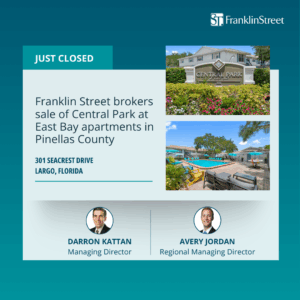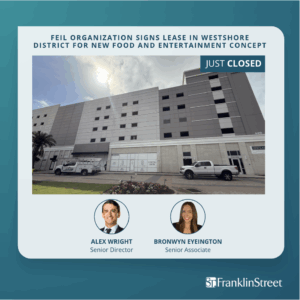It’s hardly multifamily, but industrial real estate has emerged as somewhat of a darling in its own right as the economy continues strengthening and performance drives up property values. Indeed, industrial markets around the country are bouncing back – and some are preparing for a bona fide boom.
The industrial landscape is being redefined by surging demand from e-commerce, traditional retailers, the manufacturing sector and third-party logistics providers, according to Marcus & Millichap’s National Industrial Research Report for the first half of 2014. Beyond ports and intermodal hubs, market dynamics are pushing industrial real estate to secondary markets and even tertiary metros as US exports blow past their 2008 peak. US exports totaled #2.3 trillion in 2013, according to the US Department of Commerce.
A quick look at market stats magnifies the opportunities in industrial. MMI predicts about 120 million square feet of new supply is set to come on line in 2014. That’s a whopping 61% increase over 2013. The good news is most of the product has pre-committed leases or is build-to-suit. And even with all the new supply, MMI expects the national vacancy to hit a cyclical 7.1% low by year-end with 239 million feet absorbed. Meanwhile, asking rents rose by an average of 5.1% and concessions started melting away in the first half of 2014.
“The industrial capital markets continue to be on fire,” says Bill Waxman, EVP of CRE’s Global Port Logistics Group. “Investors are no longer looking at industrial as a stepchild but, rather, as the white night. Capitalization rates across the country are declining and, as a result, we’re seeing a huge amount of demand for a less-than-huge amount of supply. There’s a great competition among global, national and local investors for the same rare product.”
The State of the Market
Robust net absorption of industrial space should continue throughout 2014 and 2015, with 211 million and 205 million square feet, respectively, NAIOP predicted in an August report authored by Dr. Hany Guirguis and Dr. Joshua Harris. Those figures are about 100% above numbers posted 2011 and 2012 as the industrial market sees a full-swing recovery.
Industrial demand remains hot for all types of industrial space – fulfillment/distribution center, warehouse, manufacturing and flex,” says Thomas Bisacquino, president and CEO of NAIOP. “A unique area of potential growth for industrial is in energy production and transport, as the national has renewed focus on domestic energy resources, and the possibility that the US may begin exporting natural gas to Europe. These activities will likely generate increased industrial demand in port cities with high concentrations of energy production and supply chain activities.”
Dwight Hotchkiss, president of brokerage services for Colliers International, points to a solid uptick in manufacturing activity as a strong driver. The Institution of Supply Management’s Purchasing Managers Index (PMI) reveals economic activity in the manufacturing sector expanded in August 2014 for the 15th consecutive month. Seventeen of the 18 manufacturing industries are reporting growth. With economists agreeing that manufacturing’s back on track, overbuilding is not on the lips of industrial real estate industry watchers. In fact, Waxman says development demand is strong.
“In every major and secondary market, there continues to be new development – there’s currently more than 11 million square feet under development in New Jersey alone – and this is the right amount of development,” Waxman says. “Markets won’t see an oversupply but will eventually reach equilibrium. This new development is directly in response to a healthy demand for leasing nationally and the continual activity on both fronts is bound to progress to productivity.”
Identifying the Hot Spots
Even in a white hot industrial real estate industry, some locations are still hotter than others. Atlanta is one of the undisputed bright spots, according to Doug Smith, SVP of Seefried Industrial Properties. He says Atlanta industrial is as healthy as it was in the mid-2000s.
“Couple that with a continued drought of new construction, and we are approaching historically low vacancy rates in certain submarket and product types,” Smith says. “All of that leads to rising rental rates and overall property values. Currently, there is minimal construction activity for speculative product in the Atlanta market, while at the same time the region has enjoyed nearly 20 million square feet of absorption since the beginning of 2013.”
From an investment perspective, Smith continues, Atlanta remains a “must have” market for most institutional buyers, but there is not enough supply out there for the level of investment demand. The result: recent buildings have traded at record low cap rates for these product types and the threshold in cap rates between class A and class B product is approaching an all-time low for the first time in many years.
Meanwhile, Hotchkiss points to the Inland Empire as a perennial hot spot. Although this area has been strong for some time, it continues to thrive thanks to its location next to the Port of Long Beach. But he notes plenty of other cities are also witnessing a significant industrial uptick.
“Dallas has seen tremendous activity the past four quarters but is showing some signs of slowing down,” Hotchkiss says. “Chicago and Atlanta, top five markets in size and importance, have seen a strong pickup in activity. Charleston and Greenville, SC are showing strength, with car manufacturers like BMW setting up production. Other cities within the Southeast and Mid-Atlantic are anticipated to show strong gains due to the growth of East Coast ports to service the re-opened Panama Canal.”
The auto industry is certainly driving gains. Jim Holleman, a principal at Cushman & Wakefield | Cornerstone, reports activity in East Tennessee among automotive manufacturers and suppliers. Recent announcements of expansions at the Volkswagen plant in Chattanooga, which will add 2,000 jobs, and SL America Corp. in Clinton, adding 1,000 jobs, are just two examples of this trend.
“Areas that benefit from strong transportation and logistics infrastructure and close proximity to large population centers are seeing some strong wins among distribution prospects,” Holleman says.
Of course, all industrial markets with a port and well-connected transportation are reflecting improved activity. Monte Merritt, senior director with Franklin Street in Jacksonville, notes firms want to move and expand in cities where they can move their goods easily and quickly.
“In the state of Florida, Miami and Jacksonville are the ports showing the strongest improvement,” Merritt says. “Going up the East Coast, Savannah and Charleston along with New York’s harbor are improving as well. As far as industrial sectors, distribution warehousing is still a top area to watch within the industrial market. Manufacturing continues to improve as well. In June 2013, NAIOP projected that 20 million new industrial-related jobs will be created between 2013 and 2020 – halting a decades-long trend of job shredding in the industry.”
Keeping an Eye on Challenges
E-commerce is a hot topic in the industrial market, but, as noted, vehicle sales have also played a key role in the industrial rebound over the past 18 months. Doug Fura, vice president of NAI Farbman, reports a new challenge emerging as a result: securing quality buildings for users in larger size ranges.
“Several million square feet of buildings were demolished over the last several years and speculative construction ha snot yet truly commenced,” Fura says. “We are therefore seeing a low inventory of larger facilities. This is ultimately a good challenge for real estate developers as it will force companies to consider build to suit options. Corporations in need of industrial space are rising from a period of quiet to a high volume but came out of the last cycle being more meticulous in their real estate due diligence.”
Waxman is concerned about the “last mile.” Last Christmas, UPS and FedEx were overwhelmed by the huge demand from companies like Amazon and Target and, as a result, weren’t able to deliver packages on time. Consumers, however, are demanding quick and reliable service. Although that’s an occupier issue, it trickles down to developers. The good new is, developers are responding.
“Developers and owners have done a good job of taking older buildings and converting them to meet the standards needed to be key player in the e-commerce world,” Waxman says. “Similarly, new buildings that are being constructed are thought of in terms of e-commerce capabilities. In this day and age, development is not just about bricks and mortarg, but also about how the building and layout will ‘perform’ for different types of users.”
Environmental concerns are also among the discussions among industrial real estate watchers. Andrew Maguire, an attorney in MacCausland Keen & Buckman’s real estate group, points to a heightened sensitivity to environmental matters in industrial deals, particularly when the seller has manufactured or stored hazardous materials on the property.
“Uncorrected violations of environmental laws can be a significant impediment to industrial transactions – the costs and uncertainties associated with remediation can deter prospective buyers,” Maguire says. “It can also be very expensive for owners of aging, outmoded industrial properties to keep their buildings code-compliant and compatible with the expectations of prospective tenants.”
The Real Panamax Impact
The heated disagreement about how the expansion of the Panama Canal will ultimately play and who will benefit in the years ahead is alive and well. Some may be growing tired of the Panamax impact discussion but talk won’t die down until well after the project is complete in early to mid-2016. Although the debate continues, Merritt sees it as an area that could spark “tremendous growth” for Florida.
“The Miami port is ready now for the Panamax ships and Jacksonville has received all approvals necessary for the required dredging and is currently working on its funding for this work,” Merritt says. “The impact of allowing these ships is tremendous.”
Merritt points to Hanjin Shipping Co., Korea’s largest and one of the world’s top 10 container carriers. The company pulled out of its decision to build a $300-million container shipping terminal at the Port of Jacksonville in 2013 because the current port could not support its shipping needs. JAXPORT officials had previously reported that Hanjin terminal would have brought the city more than 5,600 jobs and nearly $1 billion in annual impact. Stories like these are causing cities is to scramble toward the opportunity. Still, some are skeptical about the impact.
“I think that the issue of the Panamax can be compared to all of the ‘what ifs’ of Y2K back at the start of the century,” Waxman says. “There are a lot of unknowns and all of this planning and plotting is definitely valuable, but at the end of the day I think we’ll see the same number of TEUs [20-foot equivalent units] coming to the East Coast ports. However, we’ll also see more containers on one ship and fewer ships overall. This will reduce the ton-mile cost of each individual product and, in turn, reduce the costs of transportation and goods.”
Looking Ahead
With most predicting the economy likely should continue a slow to moderate growth trend in terms of GDP and employment growth, NAIOP researchers Harris and Guirguis forecast the same for industrial space demand.
“While we are encouraged by this positive growth in industrial, it is important to recognize that the same demand isn’t being experienced across the industry,” says Bisacquino. “The commercial real estate industry as a whole has yet to reach its full potential, due to uncertainties about fiscal policy and unsteady economy.”
From Merritt’s point of view, industrial markets will see expansion in new construction and tenants. After some months of positive improvement it seems our economy will continue to rebound as the economy continues to improve and the vacancy rate continues. But he offers an important “however, if.”
“However, if construction stays dormant, as it has in some areas like Jacksonville, absorption will continue to increase and landlords will be able to include rental rate increases,” he says. “Overall, the industrial market seems to be correcting itself, absorption is stabilizing, lease rates for the best part are held in check and are holding developers off. As a result, I’m optimistic the industrial market will continue to improve, slow but steady. Time will tell.”
Even with the predicted slowing in 2015, the keyword among industrial industry watchers is bullish. Waxman calls this an exciting time for industry and looks forward to seeing the impact of changes on several fronts.
“The changes in the logistics world upset the status quo and I think that the real estate industry has done a great job of reacting to it and will continue to do so,” he concludes. “In the foreseeable future, I think we’ll see continued strong activity, new construction and re-adaptation and should expect to reach equilibrium within the next year.” View PDF



